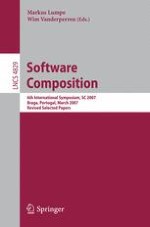OnbehalfoftheOrganizingCommitteewearepleasedtopresenttheproceedings ofthe2007SymposiumonSoftwareComposition(SC2007).ThegoalofSC2007 wastobringtogethertheresearchandindustrialcommunitiesinordertoaddress the challenges of the component-based softwaredevelopment approach. SC 2007 was the sixth symposium on software composition in the SC series that seeks to develop a better understanding of how software components may be used to build and maintain large software systems. This LNCS volume contains the revised versions of the papers presented at SC 2007, which was held as a satellite event of the European Joint Conferences on Theory and Practice of Software (ETAPS) in Braga, Portugal, March 24–25, 2007. The symposium began with a keynote on “Composition by Anonymous Parties” by Farhad Arbab (CWI and Leiden University). The main program consisted of six technical sessions related to speci?c aspects of component-based software development. In response to the call for papers, we received 59 submissions from over 20 countries and 6 continents. Each paper was reviewed by at least three Program Committeemembers.TheentirereviewingprocesswassupportedbyMicrosoft’s Conference Management Toolkit. In total, 15 submissions were accepted as full papers and 5 submissions were accepted as short papers.
